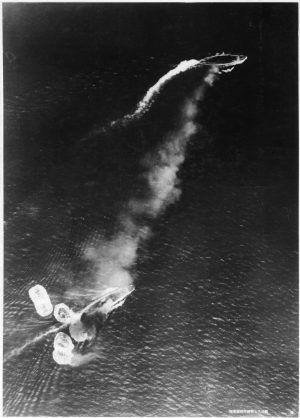Seventy-nine years ago today, Japanese aircraft found and destroyed Force Z, consisting of the battleship Prince of Wales and the battlecruiser Repulse. The battle confirmed Japan’s naval dominance over the South China Sea but became famous as a marker of the shift of naval power from the battleship to the aircraft carrier. The real story, as is often the case, is considerably more complicated.
The British government ordered HMS Prince of Wales (a modern fast battleship) and HMS Repulse (an aging but fast battlecruiser) to the Far East in late 1941 in order to deter Japanese aggression. The ships evidently failed to do this, although Prince of Wales was the most powerful single surface unit in the theater when war broke out. Shortly after December 7, as it became evident that Japan was launching a wide-ranging offensive against targets across Southeast Asia, the two battleships, accompanied by four destroyers, were ordered to hunt down and intercept Japanese invasion convoys. Unfortunately, they lacked substantial fighter support.
The Japanese had been aware of the presence of the ships since before the war, and received submarine and aerial reports of their sortie. They allocated a large surface force, including two battlecruisers and numerous cruisers and destroyers, to protect the vulnerable invasion convoys on their way to Malaya. The contending surface forces passed as near as five miles from one another during the morning of December 10, but did not sight each other or engage.
A large flight of G3M and G4M bombers launched from bases in Indochina on the early morning of December 10, having received several conflicting reports of the British ships’ position during the night. These were not carrier aircraft, but rather long-range twin-engined bombers designed for maritime attack. They hunted the British ships for several hours before finally receiving a reliable report of the British position. Concerns over fuel forced the Japanese to attack in piecemeal fashion. Both of the British battleships were struck by multiple bombs and torpedoes, each succumbing by early afternoon.
Even more than Pearl Harbor, the sinking of the two British battleships served to convince political and naval authorities of the pre-eminence of airpower in the Pacific. The Pearl Harbor attack, like the Taranto raid before it, had sunk several anchored, stationary battleships after achieving nearly complete surprise. The Repulse and Prince of Wales were fast warships operating at speed and capable of maneuvering, and they still fell victim to the attacks. Indeed, the destruction of Force Z is sometimes used as an example of the sudden impact of military technological revolutions, where old doctrines and equipment are rendered obsolete in a flash.
The truth is always more complex, of course. Admirals in the Pacific may have over-learned the lesson and become far too cautious about the employment of surface warships during the day in the first years of the war. The Japanese attack depended on some good luck, and could not have been easily replicated with carrier aircraft alone, which operated at shorter ranges and carried lighter payloads. Force Z could easily have encountered the Japanese cruiser force in the early morning of December 10, resulting in an engagement that would have produced an entirely different narrative. British heavy gunfire could easily have offered devastating proof of the enduring effectiveness of battleships, as the Japanese cruisers could not long have survived an engagement with the heavily armed Royal Navy ships, putting the entire invasion of Malaya at risk. On the other hand, Japan’s ship-launched “Long Lance” torpedoes might have found either or both of the British capital ships, offering a different story about the decline of the battleship.
Nevertheless, the destruction of Force Z cemented a narrative about the Pacific War, one that quickly became evident in force structure and procurement, as the contending navies turned away from the battleship and invested heavily in aircraft and aircraft carriers. Battleships would continue to perform valuable service in all navies, but their sun had begun to set.

































